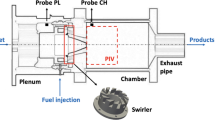Abstract
The objective of this contribution is to investigate whether the mechanism of the thermal diffusion instability in gaseous flames causing cellular flame structures also occurs during the combustion of porous solid fuel. Based on conservation for mass and energy, the relevant set of differential equations was derived. Assuming thermal equilibrium between fuel and oxidiser, a global energy equation was valid for both solid and gaseous phase. The resulting set of differential equations was discretised by the Collocation method to arrive at a system of algebraic equations. In order to investigate into cellular flame structures, an infinitesimal disturbance was superimposed onto the plane conversion front. Carrying out a linear instability analysis, yielded eigenvalues dependent on the wave number of the disturbance. A critical wave number exists below which the real part of the eigenvalues is positive, thus, indicating a regime of instability. Within this region, eigenvalues with a not-vanishing imaginary part of the eigen value existed causing cellular flame structures. However, the growth rate of disturbances was found to be small, which may explain the difficulty to investigate this phenomena experimentally.
Similar content being viewed by others
References
Markstein, G.H. and Somers, L.M., Cellular flames structure and vibrational flame movement in N-butane-methane mixtures. Fourth Symposium on Combustion, 1953.
Joseph, D.D., Stability of Fluid Motions I. Springer, Heidelberg, 1976.
Forman A.W., Combustion Theory. The Benjamin/Cummings Company, San Francisco, 1985.
Class, A.G., Zellulare strukturen laminarer staupunkflammen. Ph.D. thesis, Forschungszentrum Karlsruhe, 1995.
Joulin, G. and Mitani, T., Linear stability analysis of two-reactant flames. Combustion and Flame 40 (1981) 235–246.
Joulin, G. and Clavin, P., Linear stability analysis of nonadiabatic flames: Diffusionalthermalmodel. Combustion and Flame 35 (1979) 139–153.
Matkowsky, B.J. and Sivashinsky, G.I., An asymtotic derivation of two models in flame theory associated with the constant density approximation. SIAM J. Appl. Math. 37 (1979) 686–699.
Margolis, S.B. and Matkowsky, B.J., Nonlinear stability and bifurcation in the transition from laminar toturbulent flame propagation. Comb. Sci. Tech. 34 (1984) 45–77.
Satoshi Kadowaki., The influence of hydrodynamic instability on the structure of cellular flames. Physics of Fluids 11(11) (1998) 3426–3433.
Buckmaster, J.D. and Ludford, G.S.S., Lectures on Mathematical Combustion, Society for Industrial and Applied Mathematics, 1983.
Peters, B. and Bruch, Ch., Drying and pyrolysis of wood particles: Experiments and simulation. J. Appl. Anal. Pyrolysis 70 (2003) 233–250.
Bhattacharjee, S., Altenkirch, R.A., Srikantaiah, N. and Vedhanayagam, M., A theoretical description of flame spreading over solid combustion ina quiescent environment at zero gravity. Gordon and Breach Science Publisher Inc 69 (1990) 1–15.
Peters, B., Thermal Conversion of Solid Fuels, WIT Press, Southampton, 2003.
Henneke, M.R. and Ellzey, J.L., Modeling of filtration combustion in a packed bed. Combustion and Flame 117 (1999) 832–840.
Leach, S.V., Rein, G., Ellzey, J.L., Ezekoye, O.A. and Torero, J.L., Kinetic and fuel property effects on forward smoldering combustion. Combustion and Flame 120 (1999) 346–358.
Leach, S.V., Ellzey, J.L. and Ezekoye, O.A., Convection, pyrolysis and damkoehler number effects on extinction ofreverse smoldering combustion. Twenty-seventh Symposium on Comb., 1998, pp. 2873–2880.
Kashireninov, O.E., Yuranov, I.A., Fomin, A.A. and Shtessel, E.A., An inherently chemical mechanism for auto-oscillations insolid-state combustion. Combustion and Flame 121 (2000) 430–438.
Zik, O. and Moses, E., Fingering Instability in Solid Fuel Combustion: The Characteristic Scales of the Developed State. Twenty-Seventh Symposium on Combustion, 1998.
Zhang, Y., Ronney, P.D., Roegner, E.V. and Greenberg, J.B., Lewis number effects on flame spreading over thin solid fuels. Combustion and Flame 90 (1992) 71–83.
Finlayson, B.A., The Method ofWeighted Residuals and Variational Principles, Academic Press, New York, 1972.
Clavin, P. and Linan, A., Theory of caseous combustion. Nato ASI Series B 116, 1984.
Kuo, K.K., Principles of Combustion, John Wiley & Sons, New York, 1986.
Wolfram, S., The Mathematica Book, Cambridge University Press, Cambridge, 1996.
Author information
Authors and Affiliations
Rights and permissions
About this article
Cite this article
Peters, B. Cellular structures in solid fuel combustion. Flow Turbulence Combust 73, 217–229 (2005). https://doi.org/10.1007/s10494-005-4031-8
Received:
Accepted:
Issue Date:
DOI: https://doi.org/10.1007/s10494-005-4031-8



